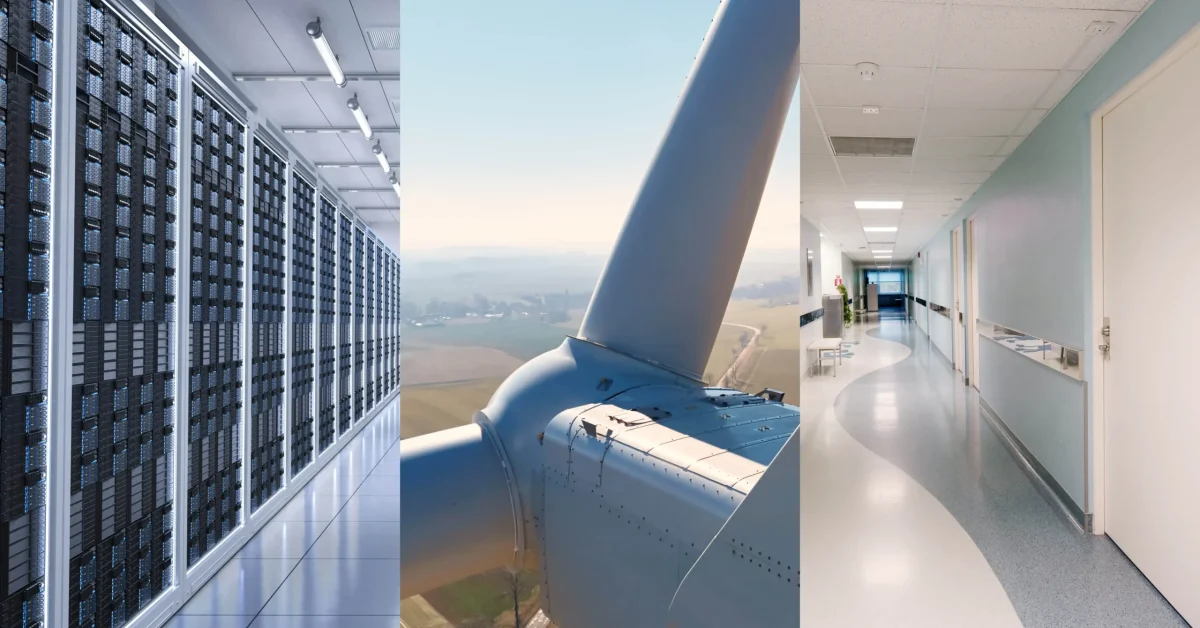Why General Contractors Will Focus on Data Centers, Power, and Healthcare in 2025-26

Table of Contents
Share this post
In 2024, the Engineering and Construction Industry saw significant expansion. Construction firms in the U.S. delivered over $2 trillion in projects and employed a record 8.3 million people despite ongoing challenges like inflation and high interest rates.
Looking ahead to 2025-26, the overall construction volume may hold steady or even grow slightly, but the picture for winning profitable work is shifting.
Opportunity is concentrating in specific, high-demand sectors. Data centers, power infrastructure, and healthcare are set to dominate project pipelines, requiring specialized skills and execution strategies.
Success in the years ahead will hinge on more than just how well you build, but also what you build and where.
This article will break down where the major project opportunities lie.
Data Centers, AI, and Edge Driving Construction Spend
Construction growth is increasingly concentrated in specialized areas, moving beyond traditional sectors.
The AIA Consensus Construction Forecast points to areas often hidden within broader categories, while ConstructConnect’s report specifically highlights cloud computing, AI infrastructure, and edge computing as key drivers of U.S. project starts and spend.
This surge is fueled by the explosion in data generation, the computational power required for artificial intelligence, and the need for faster, localized processing at the network edge.
Developing such advanced digital infrastructure is vital, as it enables innovation across industries, and allows for seamless connectivity for education, healthcare, and daily life.
The opportunity here lies in these mission-critical, MEP-intensive environments.
Infrastructure: Power, Engineering, and Transportation
U.S. engineering and public works are expected to be the fastest-growing construction category through 2026. ConstructConnect forecasts substantial growth in civil construction spend through 2026, projecting volume well over $500 billion.
This expansion is driven by federal investment, aging systems, and widespread electrification.
Investing in infrastructure is a must for boosting economic competitiveness, improving public safety, and ensuring the reliable delivery of power, water, and transportation services that underpin daily life.
Power infrastructure is leading the pack here, projected for rapid growth in the coming years as grid upgrades, EV charging networks, and renewables take center stage.
Transportation infrastructure rounds out this segment with solid growth projected through 2026, with road, bridge, and transit projects ramping up across the U.S.
Healthcare: Steady as Heartbeat
Healthcare construction keeps moving ahead steadily. As people live longer and the population ages, the need for local, high-quality medical facilities increases.
This ongoing investment in healthcare infrastructure is crucial for societal well-being, so that communities have the necessary resources to support public health and quality of life for all.
Driven by this aging population, shifting care models, and ongoing provider consolidation, demand for adaptable facilities remains strong.
The momentum is shifting away from mega-hospital campuses and directly toward neighborhood clinics, ambulatory care centers, and specialized treatment hubs. Such facilities offer flexible, high-compliance spaces built for speed and efficiency.
Closing Reflections: Key Takeaways for General Contractors
The U.S. construction sector is undergoing changes, with significant opportunities in data centers, critical infrastructure, and healthcare.
This demands that general contractors adopt a sharp, focused strategy to identify and pursue profitable work effectively. A generalist approach is less likely to capture the most valuable projects in this kind of environment.
Entering these specialized sectors can be challenging due to the need for prior experience. But GCs can overcome this by starting with smaller projects to build expertise or by partnering with companies that possess the necessary capabilities.
Your takeaways are clear: understand where the market is growing, focus your business development efforts there, and align your expertise, resources, and training with these specific vertical demands.
Such a thorough approach is crucial for mitigating risks, maximizing profitability, and positioning your firm for sustained success in 2025-26 and beyond.
